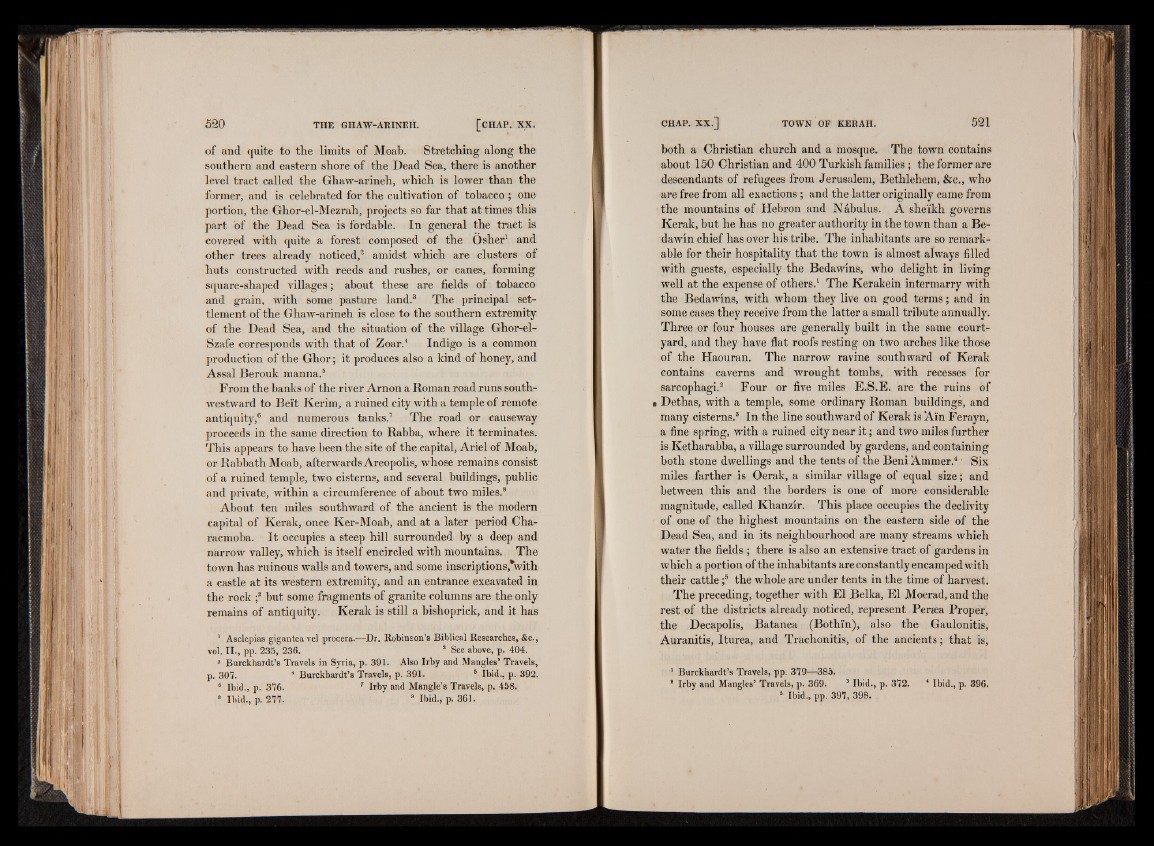
of and quite to the limits of Moab. Stretching along the
southern and eastern shore of the Dead Sea, there is another
level tract called the Ghaw-arineh, which is lower than the
former, and is celebrated for the cultivation of tobacco ; one
portion, the Ghor-el-Mezrah, projects so far that at times this
part of the Dead Sea is fordable. In general the tract is
covered with quite a forest composed of the Osher1 and
other trees already noticed,2 amidst which are clusters of
huts constructed with reeds and rushes, or canes, forming
square-shaped villages; about these are fields of tobacco
and grain, with some pasture land.3 The principal settlement
of the Ghaw-arineh is close to the southern extremity
of the Dead Sea, and the situation of the village Ghor-el-
Szafe corresponds with that of Zoar.4 Indigo is a common
production of the Ghor; it produces also a kind of honey, and
Assal Berouk manna.5
From the banks of the river Arnon a Roman road runs south-
westward to Bei't Kerim, a ruined city with a temple of remote
antiquity,6 and numerous tanks.7 The road or causeway
proceeds in the same direction to Rabba, where it terminates.
This appears to have been the site of the capital, Ariel of Moab,
or Rabbath Moab, afterwards Areopolis, whose remains consist
of a ruined temple, two cisterns, and several buildings, public
and private, within a circumference of about two miles.8
About ten miles southward of the ancient is the modern
capital of Kerak, once Ker-Moab, and at a later period Cha-
racmoba. It occupies a steep hill surrounded by a deep and
narrow' valley, which, is itself encircled with mountains.. The
town has ruinous walls and towers, and some inscriptions, with
a castle at its western extremity, and an entrance excavated in
the rock f but some fragments of granite columns are the only
remains of antiquity. Kerak is still a bishoprick, and it has
1 Asclepias gigantea vel procera.—Dr. Robinson’s Biblical Researches, &c.,
vol. II., pp. 235, 236. 2 See above, p. 404.
8 Burckhardt’s Travels in Syria, p. 391. Also Irby and Mangles’ Travels,
p. 301. 4 Burckhardt’s Travels, p. 391. 5 Ibid., p. 392.
‘ Ibid., p. 316. 7 Irby and Mangle’s Travels, p. 458.
0 Ibid., p. 211. 9 Ibid., p. 361.
both a Christian church and a mosque. The town contains
about 150 Christian and 400 Turkish families ; the former are
descendants of refugees from Jerusalem, Bethlehem, &c., who
are free from all exactions ; and the latter originally came from
the mountains of Hebron and Nabulus. A sheikh governs
Kerak, but he has no greater authority in the town than a Be-
dawin chief has over his tribe. The inhabitants are so remarkable
for their hospitality that the town is almost always filled
with guests, especially the Bedawins, who delight in living
well at the expense of others.1 The Kerakein intermarry with
the Bedawins, with whom they live on good terms; and in
some cases they receive from the latter a small tribute annually.
Three or four houses are generally built in the same courtyard,
and they have flat roofs resting on two arches like those
of the Haouran. The narrow ravine southward of Kerak
contains caverns and wrought tombs, with recesses for
sarcophagi.2 Four or five miles E.S.E. are the ruins of
t Dethas, with a temple, some ordinary Roman buildings, and
many cisterns.3 In the line southward of Kerak is Ain Ferayn,
a fine spring, with a ruined city near i t ; and two miles further
is Ketharabba, a village surrounded by gardens, and containing
both stone dwellings and the tents of the Beni Ammer.4 ? Six
miles farther is Oerak, a similar village of equal size; and
between this and the borders is one of more considerable
magnitude, called Khanzir. This place occupies the declivity
of one of the highest mountains on the eastern side of the
Dead Sea, and in its neighbourhood are many streams which
water the fields ; there is also an extensive tract of gardens in
which a portion of the inhabitants are constantly encamped with
their cattle ;5 the whole are under tents in the time of harvest.
The preceding, together with El Belka, El Moerad, and the
rest of the districts already noticed, represent Persea Proper,
the Decapolis, Batanea (Bothi'n), also the Gaulonitis,
Auranitis, Iturea, and Trachonitis, of the ancients; that is,
1 Burckhardt’s Travels, pp. 319—385,
2 Irby and Mangles’ Travels, p. 369. 3 Ibid., p. 312. 4 Ibid., p. 396.
5 Ibid., pp. 391, 398. .